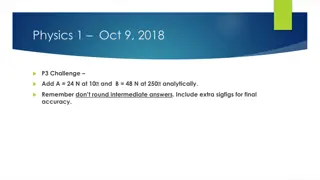Understanding Projectile Motion in Physics
A projectile, acted upon by gravity, follows a parabolic path in projectile motion. By choosing appropriate coordinates and strategies, analyzing motion along vertical and horizontal axes becomes manageable. Key formulas and strategies help in determining components of velocity, maximum height, time in the air, and distance traveled by a projectile. An example illustrates the application of these principles to solve problems involving projectile motion.
Download Presentation

Please find below an Image/Link to download the presentation.
The content on the website is provided AS IS for your information and personal use only. It may not be sold, licensed, or shared on other websites without obtaining consent from the author. Download presentation by click this link. If you encounter any issues during the download, it is possible that the publisher has removed the file from their server.
E N D
Presentation Transcript
A Projectile What is a projectile? A projectile is any object that is acted upon by gravity alone. Note that gravity acts in the negative y- direction. Air resistance is ignored in projectile motion unless explicitly stated. The path of a projectile is parabolic in nature.
Choosing Coordinates & Strategy For projectile motion: Choose the y-axis for vertical motion where gravity is a factor (ay= g = 9.8 m/s2). Choose the x-axis for horizontal motion. Since there are no forces acting in this direction, the speed will be constant (ax= 0). Analyze motion along the y-axis separate, or independently from motion along the x-axis. This is a step that most students have difficulty with. Note that time is the only variable that will always be the same for both the vertical and horizontal directions. Hence, if you can find if for the y-direction, you also have it for the x-direction, and vice-versa.
Strategies Continued If the projectile is fired horizontally, then voywill be zero. If the projectile is launched at an angle greater than 0o, then vywill be 0 m/s at the very peak of its trajectory. A common misconception is that the acceleration = 0 m/s2at the peak as well. But it actually equals -9.8 m/s2, and anywhere else along the path of the projectile The magnitude of the initial launch velocity will be the same as the final velocity if the projectile lands at the same height from which it is launched. If the projectile lands at the same height from which it is launched, then ? = 0. ox ox o ox iy ox ox v = vo oy
Formulas You Will Use x-direction: ? ??= ??? ? = ??? (velocity is constant since ax = 0) ??= ? cos y-direction: ? ??= (???+ ??) ? = ???? ? ??= ??? ?? ? ??= ??? ? ?(?)2 ??2 = ???2 2?? ?? = ? sin
Example #1: Determining the vertical and horizontal components, and maximum height of a projectile A child kicks a soccer ball with an initial velocity of 8.5 meters per second at an angle of 35 with the horizontal, as shown. The ball has an initial vertical velocity of 8.5 meters per second at 35 relative to the horizontal. [Neglect air resistance.] 1. Determine the horizontal and vertical components of the ball s initial velocity. 2. Determine the maximum height reached by the ball. 3. Determine the total amount of time the ball is in the air. 4. Determine how far the ball travels before it hits the ground.
Example #1 (Part 1): Determine the vertical and horizontal components of the initial velocity. For the vertical and horizontal velocities, you need to use component vector analysis using trigonometry. Begin by creating a right triangle with the vertical and horizontal components making up the a and b legs of the right triangle. voy 35 vox
Example #1 (Part 1 - cont.): Using trigonometry: ???= ??sin = (8.5 ?/?)(sin35 ) = 4.9 ?/? ???= ??cos = (8.5 ?/?)(cos35 ) = 7.0 ?/? ??? 35 ???
Example #1 (Part 2): Finding the maximum height. List all the known and unknown variables. (1) ??= ??? ?? (2)? = ???? ??2 (3)?2= ???2 2? ? voy vy a = g y t 4.9 m/s 0 m/s -9.8 m/s2 ? ? Find an equation where the max height y is the only variable missing. Use equation (3): ?2 = ???2 2?? ???2= 2?? ? =???2 0 = ???2 2?? 2? (4.9? 2 (9.8? ?)2 ?2) ? = ? = 1.2 ?
Example #1 (Part 3a): Finding the time of flight As before, list all the known and unknown variables. (1) ??= ??? ?? (2)? = ???? ??2 (3)?2= ???2 2? ? voy vy a = g y t 4.9 m/s 0 m/s -9.8 m/s2 1.2 m ? You have two choices of equations that you can use, (1) or (2) ??= ??? ?? Solving for t using equation (1): ? =??? 0 = ??? ?? ??? = ?? ? ? =4.9? 9.8? ? ? = 0.50 ? ?2 However, this time only covers half the flight of the ball, therefore, the total time is double, or 1.0 s
Example #1 (Part 3b): Finding the time of flight As before, list all the known and unknown variables. (1) ??= ??? ?? (2)? = ???? ??2 (3)?2= ???2 2? ? voy vy a = g y t 4.9 m/s 0 m/s -9.8 m/s2 1.2 m ? Solving for t using equation (2): Since we know that the ball will land at the same height from which it is kicked, ? = 0. ? = ???? ??2 ? =2??? 0 = ???? ??2 ???? = ??2 ? ? =2 4.9? 9.8? ? ? = 1.0 ? ?2
Example #1 (Part 4): Finding the Horizontal Distance To find the horizontal distance, you only need to be concerned with motion in the x-direction. As previously mentioned, there is no acceleration in the x-direction, therefore, vox=vx = constant. Equation (2) can be used since the portion containing the acceleration ( axt2) will be zero. Hence: (1)? = ???+ ?? (2)? = ???? + ???2 (3)?2= ???2 2?? ? ? = ???? Since the initial velocity in the x-direction and the time have already been determined: ? = (7.0? ?) (1.0?) ? = 7.0 ?
Example #2: Determining the horizontal distance, height and final velocity of a projectile launched horizontally. A projectile is launched horizontally at a speed of 30. meters per second from a platform located a vertical distance h above the ground. The projectile strikes the ground after time t at horizontal distance d from the base of the platform. [Neglect friction.] 1. Sketch the theoretical path of the projectile. 2. Calculate the horizontal distance, d, if the projectile s total time of flight is 2.5 seconds. 3. Determine the height, h, of the platform. 4. Determine the final velocity, v, when the projectile hits the ground.
Example #2(Part 1): Sketching the path. All projectiles followed a curved or parabolic path.
Example #2(Part 2): Determining the Horizontal Distance. List the knowns and unknowns: vox d t 30 m/s ? 2.5 s Equation to use: Since the velocity in the horizontal direction is constant, ??= 0. ? = ???? + ??2 ? = ???? ? = (30.0? ?) (2.5?) ? = 75 ?
Example #2(Part 3): Determining the height of the platform. And just like in the previous example, we will list those variables we know and those that we do not. voy vy a = g h t 0 m/s ? 9.8 m/s2 ? 2.5 s Since we want to find y, we will have to use either equation (2) or (3). Equation (2) is a better fit since we do not know the final velocity yet. (1) ??= ??? ?? (2)? = ???? ??2 (3)?2= ???2 2? ? = ???? ??2 = ??2 = (9.8? ?2) (2.5?)2 = 31 ?
Example #2(Part 4a): Determining the final velocity. Start by listing all variables. vox = vx voy vy a = g h t 30 m/s 0 m/s ? 9.8 m/s2 31 m 2.5 s The final velocity, v, is the vector sum of the vertical and horizontal components of the final velocity. Find the final velocity in the vertical direction using equation (1) (1) ??= ??? ?? (2)? = ???? ??2 (3)?2= ???2 2? ? ?? = ( 9.8? ??= ??? ?? ?2)(2.5?) ?? = ?? ??= 25? ?
Example #2(Part 4b): Determining the final velocity. vox = vx voy vy a = g h t 30 m/s 0 m/s -25 m/s 9.8 m/s2 31 m 2.5 s To find the final velocity, use the Pythagorean Theorem. ?2= ?2+ ?2 ??= 25? ? ?2= ??2+ ?? ??= 30? ? (30? ?)2+(25? ?)2 ? = 39? ? = ?
The figure below shows a pirate ship 560 m from a fort defending the harbor entrance of an island. A defense cannon, located at sea level, fires balls at initial speed v0 = 82 m/s. a. At what angle 0 from the horizontal must a ball be fired to hit the ship? vo a = g x y o ? 82 m/s 9.8 m/s2 560 m 0 (1) ? = ???? + ???2 (2) ? = ???? ??2 (3)???= ?? cos? (4) ???= ?? sin?
vo a = g x y o ? 82 m/s 9.8 m/s2 560 m 0 Assumptions that can be made: 1. The acceleration in the horizontal direction is zero, which simplifies equation (1). 2. Since the cannonball lands at the same height from which it was launched, ? = 0 in equation (2). (1) ? = ???? + ???2 (2) ? = ???? ??2 (3)???= ?? cos? (4) ???= ?? sin? ???= ?? sin? o = ? ???= ?? cos? 560 m
vo a = g x y o ? 82 m/s 9.8 m/s2 560 m 0 (1) ? = ???? (2) ? = ???? ??2 (3)???= ?? cos? (4) ???= ?? sin? 1. Substitute (3) into (1) to get: ? = ?? cos? ? ? = ???? 2. Set (2) equal to zero and solve for t. ? =2??? 0 = ???? ??2 ???? = ??2 ? 3. Substitute (4) into (2) to get: ? =2?? sin?? ? ???= ?? sin? o = ? ???= ?? cos? 560 m
vo a = g x y 82 m/s 9.8 m/s2 560 m 0 ? 1. We now have two equations and two unknowns: (5) ? = ?? cos? ? (6) ? =2??sin ? ? 2. Substitute (6) into (5) for t: ? = ?? cos? 2?? sin?? ? =??2 2sin??cos?? ? ? 3. Using the trig identity: 2sin?cos? = sin2? ???= ?? sin? ? =??2 o = ? sin2?? ???= ?? cos? ? 560 m
vo a = g x y 82 m/s 9.8 m/s2 560 m 0 ? 1. We can now solve for the angle : (82? 9.8? ?)2 560 ? = sin2?? ?2 ??= 27 2. Because of symmetry around 45 degrees, 63o is another possible angle. o = ? 560 m
b. How far should the pirate ship be from the cannon if it is to be beyond the maximum range of the cannonballs? Use range equation Maximum range is when the angle is set at 45 degrees. (82? 9.8? ?)2 ? =??2 ? = sin(2 45 ) sin2? ? ?2 ? = 686 ?























